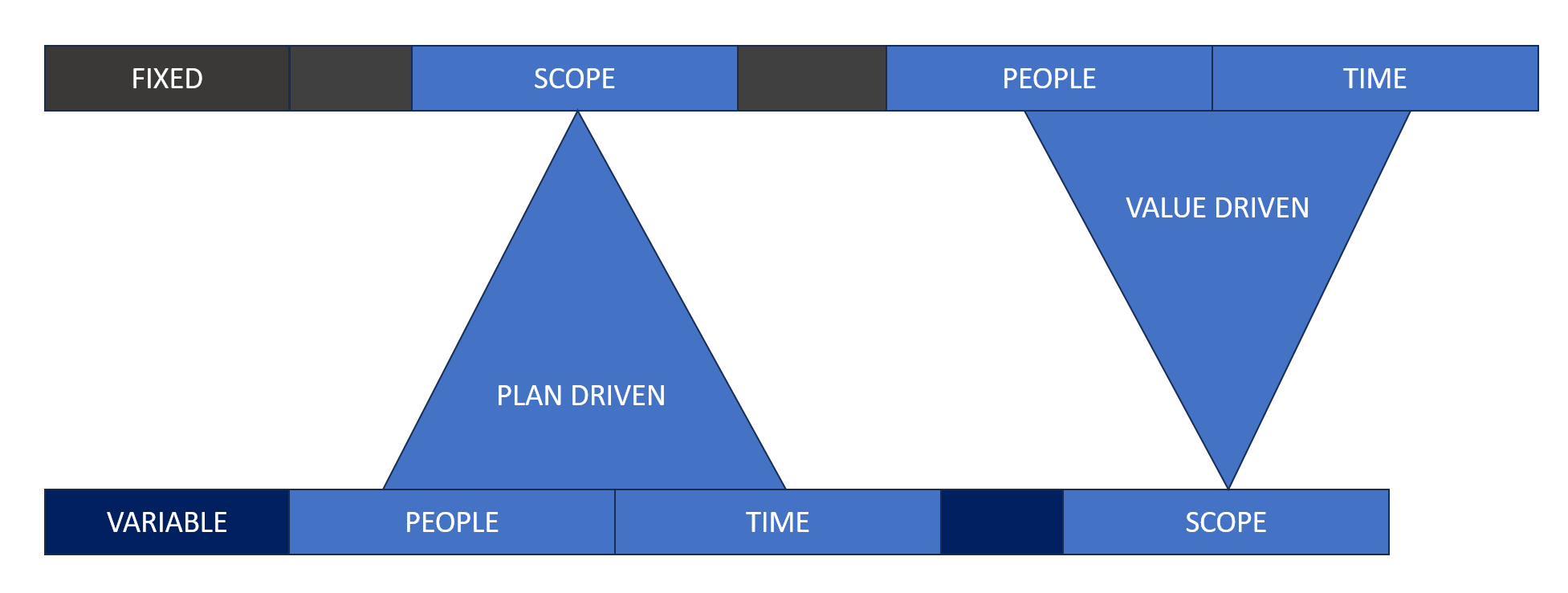Depending on what is most important, what elements need to be Fixed vs Variable on the diagram below, and how well defined a process is, can help determine what project delivery methodology to utilize to deliver your project successfully
The methodology that is chosen depends on your project’s focus. Use the information below to help assess the completeness of requirements, level of uncertainty, stakeholder needs, and align your approach to maximize efficiency and value delivery. Keep in mind each has its own strengths and weaknesses.

-
- Plan Driven – considerations
- Stable Requirements: scope will not change because the requirements are well known and understood.
- Known Process: The team is delivering the same requirements with the same constraints in the same environment utilizing the same tools as before.
- The timeframes and people needed on the team might change depending on the scope.
- Plan Driven – considerations
Examples of Plan Driven
- When I think of Plan Driven, I think of putting new tires on a fleet of vehicles. As an example, company Z owns 100 Toyota Camrys and stores them in a lot in Dallas, TX. All have had a safety recall issued on the current set of tires all of the vehicles use. The project requires that all tires be replaced with Uniroyal P500s. In this case, the scope is fixed, the cars are all equally used and have the same value, replacing tires is a known and repetitive process, so a plan driven project makes sense. Everyday 10 cars will have their tires replaced, and the timeline can be adjusted for holidays and vacations.
- Utilizing an IT example, this might be something like a corporate computer refresh or patch deployment.
- Value Driven – considerations
- Scope can change as teams gain insight and develop solutions. The solution may be theoretical or unproven requiring flexibility to adapt to emerging needs.
- The team has never delivered this solution before, with the same constraints, or in the current environment or with the tools provided.
- The team, the timebox and often the budget are fixed, but the scope can change and evolve as the team begins to deliver what will have the highest ROI with the least amount of effort.
Examples of Value Driven
- An example of Value Driven might be the creation of a new customer-facing website. The goal of the website is to convert interested parties into customers.
- Start with a Minimum Viable Product (MVP) to test the waters. This might be just getting a domain name and creating a page that gives a high-level overview of the solution provided and offers a way for people to sign up to get more information. As a result, you could start capturing interest and building a customer database. By learning more about what these potential clients’ questions are, you can start building your website to meet those needs.
- Next, adapt to market demands and pivot if needed.
What if no one was interested in your website MVP? Perhaps the market demand isn’t what you anticipated, it may need more SEO work, or it might be time to bring in a focus group, try some A/B testing, reevaluate the value proposition and in some cases maybe even scrap the idea altogether. Imagine if you did decide to scrap, the cost savings knowing upfront vs. after all of the development and deployment would be significant, not to mention the time savings. Using the same example, if you utilized the Plan Driven approach you would have to think about all of the possible scenarios that a user could face, document the requirements and start to design the pages and flow.
What each of the approaches focuses on:
| Value Driven | Plan Driven |
| People and how they interact with the current environment, (Individuals and Interactions) to help with understanding what would provide the most help and reduce pain points the fastest. | Process and Tools to help delivery to help with team onboarding and quicker delivery. |
| Getting a solution in place quickly, even if it’s only partial, and then iterating on it so that hopefully users don’t need to read documentation or training or it’s very minimal. | Comprehensive Documentation to help with onboarding, questions, and usage of solution. |
| Engage customers in frequent interactions and shared ownership. Welcome changing requirements. Delivering maximum value early and meeting customer needs and resolving pain points may end up being very different as early iterations of solutions are released. Through continuous feedback, be able to adjust to continue to take advantage of discovered opportunities that may not have previously been known. Uncertainty is expected and will be managed through anticipation, adaptation and iterating on solutions | Contract negotiation to make sure that scope is locked in prior to committing to dates and meeting those dates. Utilize a single point of contact to authorize work and make sure everything is documented. Requirements are known and frozen prior to development starting. Any change past the freeze date requires executive approval. |
| Increase Return on Investment by focusing on the continuous flow of value. As you learn more, make changes. Respond to change when needed to provide value sooner. Some solution features may only become known deep into the project. Adapt to help deliver the maximum value. | Following the Plan – Have defined releases and defined intervals. |
| Process, strategy, and practices may vary across teams in order to improve effectiveness and reliability as different situations dictate. | The delivery process is well defined and expected to be followed by teams. Changes to the process should be reviewed and implemented across teams to help maximize effectiveness and reliability. |
Ways to setup the project based on methodology used:
| Value Driven | Plan Driven | |
| Budgeting | Funds are typically allocated at a team level with the focus on delivering value. Imagine being given $100 and told to buy food for a 5-year-olds party. | Funds are allocated based on the project, taking into account # of people, duration and approved scope. Imagine being given $100 and told to by as much Campbell’s Tomato Soup as possible. |
| Scope | Scope is the problem to be solved. It is determined by value provided and level of effort needed. | Scope is typically defined before budget allocation is provided and fixed at project kickoff. |
| Team | Work is shared across teams that are focused on delivering value to the impacted functionality, capability, or product. | Team members are typically allocated at the project level for the duration of project or based on function (Dev, QA…) . |
| Schedule | Typically delivered and released in increments (sometimes time-boxed) based on priority. As the work is completed, it’s released to customers to get feedback as quickly as possible. | Planned release dates and scope defined at project initiation (X will be delivered on MM/DD/YYY) |

Selecting the right methodology from the beginning can help determine the likelihood of project success, and while Value Driven is typically Agile, and Plan Driven is Waterfall, don’t let the terminology and stigmas associated with the names impact your decision on which elements best fit your project needs.
